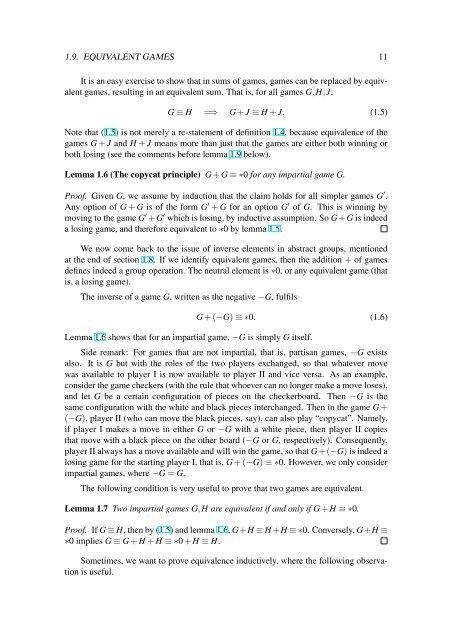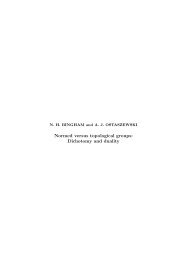Game Theory Basics - Department of Mathematics
Game Theory Basics - Department of Mathematics
Game Theory Basics - Department of Mathematics
Create successful ePaper yourself
Turn your PDF publications into a flip-book with our unique Google optimized e-Paper software.
1.9. EQUIVALENT GAMES 11It is an easy exercise to show that in sums <strong>of</strong> games, games can be replaced by equivalentgames, resulting in an equivalent sum. That is, for all games G,H,J,G ≡ H =⇒ G + J ≡ H + J. (1.5)Note that (1.5) is not merely a re-statement <strong>of</strong> definition 1.4, because equivalence <strong>of</strong> thegames G + J and H + J means more than just that the games are either both winning orboth losing (see the comments before lemma 1.9 below).Lemma 1.6 (The copycat principle) G + G ≡ ∗0 for any impartial game G.Pro<strong>of</strong>. Given G, we assume by induction that the claim holds for all simpler games G ′ .Any option <strong>of</strong> G + G is <strong>of</strong> the form G ′ + G for an option G ′ <strong>of</strong> G. This is winning bymoving to the game G ′ +G ′ which is losing, by inductive assumption. So G+G is indeeda losing game, and therefore equivalent to ∗0 by lemma 1.5.We now come back to the issue <strong>of</strong> inverse elements in abstract groups, mentionedat the end <strong>of</strong> section 1.8. If we identify equivalent games, then the addition + <strong>of</strong> gamesdefines indeed a group operation. The neutral element is ∗0, or any equivalent game (thatis, a losing game).The inverse <strong>of</strong> a game G, written as the negative −G, fulfilsG + (−G) ≡ ∗0. (1.6)Lemma 1.6 shows that for an impartial game, −G is simply G itself.Side remark: For games that are not impartial, that is, partisan games, −G existsalso. It is G but with the roles <strong>of</strong> the two players exchanged, so that whatever movewas available to player I is now available to player II and vice versa. As an example,consider the game checkers (with the rule that whoever can no longer make a move loses),and let G be a certain configuration <strong>of</strong> pieces on the checkerboard. Then −G is thesame configuration with the white and black pieces interchanged. Then in the game G +(−G), player II (who can move the black pieces, say), can also play “copycat”. Namely,if player I makes a move in either G or −G with a white piece, then player II copiesthat move with a black piece on the other board (−G or G, respectively). Consequently,player II always has a move available and will win the game, so that G+(−G) is indeed alosing game for the starting player I, that is, G + (−G) ≡ ∗0. However, we only considerimpartial games, where −G = G.The following condition is very useful to prove that two games are equivalent.Lemma 1.7 Two impartial games G,H are equivalent if and only if G + H ≡ ∗0.Pro<strong>of</strong>. If G ≡ H, then by (1.5) and lemma 1.6, G+H ≡ H +H ≡ ∗0. Conversely, G+H ≡∗0 implies G ≡ G + H + H ≡ ∗0 + H ≡ H.Sometimes, we want to prove equivalence inductively, where the following observationis useful.
















